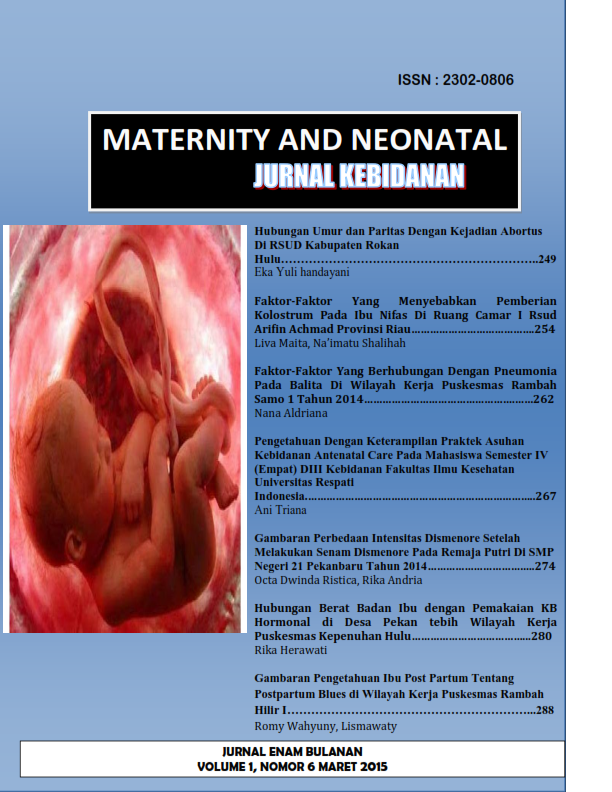Gambaran Pengetahuan Ibu Post Partum Tentang Postpartum Blues di Wilayah Kerja Puskesmas Rambah Hilir I
Keywords:
Knowledge Postpartum Blues, PHC Rambah Hilir I 2014Abstract
At the time of delivery, slumped endorphin levels and increase the risk of sad for no apparent reason, even to be a psychological disorder called postpartum blues or maternity blues. Besides influenced by hormonal changes, postpartum blues also influenced by the history of psychological disorders, marital conflict, disruption during labor, education and employment, the milk does not come out, alone in the care of the baby, without the support of her husband. Postpartum blues is a feeling of sadness experienced by mothers after childbirth. This study was conducted to determine Overview Knowledge Capital Post Partum about postpartum blues in PHC Rambah Downstream Region I. This research method is descriptive and cross-sectional research design. The location of this research in the area PHC Rambah Downstream I and was conducted in April-June 2014. The population in this study were all post-partum maternal health center working area Rambah Downstream first 44 people, and 44 samples were taken by total sampling. Gauges in this study was a questionnaire of 20 questions. The type of data in this study are primary data. The results of this study, namely, either a number 6 (13.6%), enough category of 16 people (36.4%), and less category amounted to 22 people (50%). The conclusion of this study is that the overall level of knowledge about postpartum maternal postpartum blues majority knowledgeable about the 22 people (50%). Based on this study, it is expected the local health workers to be able to provide the best services for post partum mothers, and also takes an active role each post partum mothers to know about postpartum blues, so any post partum mothers have good knowledge about postpartum blues.References
Bobak. (2005). Buku Ajar Keperawatan Maternitas. Jakarta : EGC
Hidayat, Alimul. (2010). Metodelogi Penelitian Kebidanan dan Teknik Analisa Data. Surabaya : Salemba Medika.
Mansur, Herawati. (2009). Psikologi Ibu dan Anak Untuk Kebidanan. Jakarta: Salemba Medika.
Marmi. (2012). Asuhan Kebidanan Pada Masa Nifas “Peuperium Care”. Yogyakarta : Pustaka Pelajar.
Notoatmodjo, S. (2010). Metodologi Penelitian Kesehatan. Jakarta : Rineka Cipta.
Notoatmodjo, S.(2007). Ilmukesehatan Masyarakat. Jakarta : Rineka Cipta.
Pieter, Zan. (2011). Pengantar Psikologi Untuk Kebidanan. Jakarta: Kencana.
Ragil, Putri. (2013). Hubungan Dukungan Sosil Suami dengan Gejala Gangguan Psikologi Post Partum Blues Selama Masa Nifas Pada Ibu Primipara. (http://old.fk.ub.ac.id/artikel/id/filedownload/keperawatan/Putri%20Ragil, diakses 26 Februari 2013)
Rahmi. (2013). Faktor-Faktor Yang Berhubungan Dengan Kejadian Syndrom Baby Blues Pada Ibu Post Partum. (http://simtakp.stmikubudiyah.ac.id/docjurnal/CHAIRUNNISA-jurnal_nisa, diakses 26 Februari 2013)
Rukiyah, Yeyeh. (2010). Asuhan Kebidanan III Nifas. Jakarta: Trans sInfo Media.
Setiawan, Ari. (2011). Metodologi Penelitian Kebidanan DIII, DIV, S1, dan S2.Yogyajarta: Nuha Medika.
Suryani, Eko. (2008). Psikologi Ibu dan Anak. Yogyakarta: Fitramaya.
Yuliani. (2013). Pengaruh Faktor Psikologis Terhadap Terjadinya Post Partum Blues Pada Ibu Nifas.


